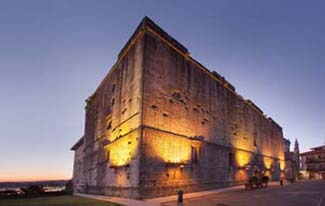
Photos courtesy of Parador de Hondarribia
Plaza de Armas, 14
20280 Hondarribia
(Guipúzcoa)
Tel: ++34 943 64 55 00
Fax: ++34 943 64 21 53
Official parador website
Reserve with Booking.com
36 rooms
Double rooms: 158–258 euros
Single rooms: 80% of double
room rate
Rates include breakfast and tax.
Free Wi-Fi
Open: all year
Hondarribia is 21 km east of San Sebastian, and a few km from Irún on the French border. As you near the town, you’ll see the Aeropuerto sign. At a large traffic circle with a statue in the middle, turn left up the hill. Look for the castle on the plaza. The nearest train station is in Irún.
Nearby: horseback riding; golf; sea fishing; mountain biking; excursions to French Basque country and San Sebastian (30-minute bus ride)
Never in the last 1000 years would anyone have imagined that this site of constant assaults would someday provide comfortable accommodation to vacationers.
Completely restored today, the castle looks ready for a siege. Its bullet-pocked, 10-meter-thick walls are massive and severe. Only five windows break up the stonework of its forbidding façade. (In contrast to such austerity, delightful baronial houses, with overhanging balconies filled with bright flowers, are just across the medieval plaza.)
The castle’s interior features enormous Gothic arches, winding stairways, and galleries hung with heraldic flags, tapestries, lances, wrought-iron chandeliers, wall sconces, and escutcheons. Outside, the flagstone courtyard holds an ancient well that once provided the castle with water during its era of constant siege warfare, and a terrace is a fine spot to gaze at the vast coastline extending into France.
Comfortable guest rooms are located in the former palace section of the castle. Many have canopied beds and views of the Bidasoa Estuary. Rooms have heating but not air-conditioning; however, the thick stone walls keep interiors cool.
Note, too, that this parador does not have a restaurant, but many fine ones exist within walking distance.
![]() Lovely outside terrace on which to enjoy drinks
Lovely outside terrace on which to enjoy drinks